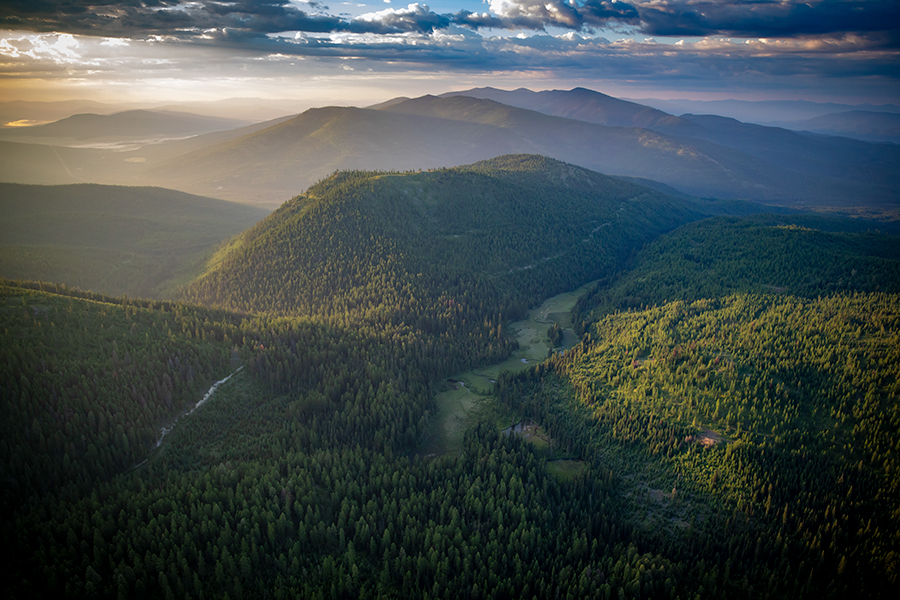‘Once-in-a-lifetime’ Land Deal Would Provide Critical Missing Piece of Protection
Groups and agencies work with Southern Pine Plantations to create a working forest with permanent public access
By Tristan Scott
In the span of a week, two major land deals to place more than 230,000 acres of prime hunting and timberland into conservation easements are acting in tandem to complete the missing piece of more than 20 years of conservation work.
Last week, federal land and wildlife resource managers with the U.S. Fish and Wildlife Service announced their effort to place 100,000 acres of land into conservation easements west of Kalispell, protecting parcels in Flathead and Lincoln counties from private development in perpetuity while also ensuring continued public access, as well as allowing the property to be sustainably managed for timber production.
Days later, the Trust for Public Lands announced its proposal to similarly protect an additional 130,000 acres of adjacent land that for generations has formed a recreational backyard for residents to hunt, fish and hike.
The two projects are the Lost Trail Conservation Area, which is proposed by the federal Fish and Wildlife Service and is currently in the public scoping period, and the Montana Great Outdoors Project, which was announced by the Trust for Public Lands and landowner Southern Pine Plantations and would be held in an easement through a partnership with Montana Fish, Wildlife and Parks.
The majority of the property in both projects is owned by Georgia-based Southern Pine Plantations (SPP), a real estate and timberland investment firm that paid $145 million in cash to the previous owner, Weyerhaeuser Co., in exchange for 630,000 acres, initially raising concerns among public land users in the region about whether the new owner might subdivide the parcels and sell them for private development.
Instead, the conservation opportunities are some of the region’s largest in years, and when combined with past efforts stitch together 317,000 acres of conservation work over the last two decades, setting aside critical wildlife habitat connecting Glacier National Park to the Cabinet Mountains Wilderness to the Selkirk and Coeur d’Alene mountains.
“The opportunity to protect this property completes the connectivity of previous conservation efforts and would ensure permanent public access to a highly used recreational corridor. It is truly a once-in-a-lifetime opportunity,” Dick Dolan, the Trust for Public Land’s Northern Rockies director, said.
If a conservation easement is secured on the property it will be protected from future development while remaining in private hands so its timber can be actively managed for the long-term. The public will also be provided permanent access to the property for recreation.
“We recognize that a viable timber industry and outdoor recreational access are both important to the people of Montana,” SPP Manager Pat Patton said. “If a conservation easement can be secured on these lands, it will provide a long‐term solution toward preserving both.”
The Trust for Public Land is working closely with state and federal government agencies to secure long-term conservation solutions for these lands. As envisioned, Montana Fish, Wildlife, and Parks would hold conservation easements on the chain of lakes lands. If the proposed Lost Trail Conservation Area is approved, the United States Fish and Wildlife Service could hold easements on the lands surrounding the existing Wildlife Refuge.
Private philanthropy will be a critical part of fundraising to protect this landscape, and Dolan said there is a narrow opening to ensure the funding is accomplished.
Lincoln County Commissioner Mark Peck said the land deals provide relief to a large segment of the hunting and fishing population concerned about development pressures bearing down on the property.
“The sale of Weyerhaeuser’s Montana lands was a crushing blow to the citizens of Lincoln County and left us wondering what could become of these core recreational lands and our timber-based economy,” Peck said in a statement. “The willingness of SPP to work with TPL is a win-win solution and a wonderful opportunity for the residents of Northwest Montana. We understand that timing is of the essence to keep this opportunity alive. We encourage all Montanans who are passionate about the future of this land to reach out to your elected officials and let them know you support this effort.”
Montana’s congressional delegation is expected to fully support the land deals, both of which would use federal Land and Water Conservation Fund (LWCF) dollars to purchase the easements within the conservation area. That funding is derived from federal offshore oil and gas leasing royalties and not taxpayer dollars.
The timing of the conservation easement proposals are serendipitous in that it follows on the heels of the U.S. Senate’s recent passage of the Great American Outdoors Act, which would authorize full and permanent funding of the LWCF, allowing annual allocations of up to $900 million, for which projects like Lost Trail are ripe. The measure still needs approval by the House but has garnered strong bipartisan support.
“Montana’s landscapes are the envy of the world, and today’s announcement is great news for our economy and our state,” U.S. Sen. Jon Tester said in a statement last week. “I’m grateful to all the folks who played a role in making this happen, and I look forward to continuing our work to ensure these lands — and the outdoor recreation economy that depends on them — will remain open to the public for generations to come.”